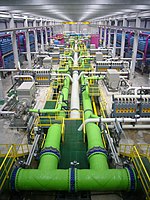
Photo from wikipedia
The quality of crustaceans' flesh has direct impact on consumers' purchase choices, with water environment and dietary nutrition being effective ways to regulate flesh quality. The aim of present study… Click to show full abstract
The quality of crustaceans' flesh has direct impact on consumers' purchase choices, with water environment and dietary nutrition being effective ways to regulate flesh quality. The aim of present study was to investigate the impacts of water salinity (low, 4 and medium, 23) and dietary lipid source (fish oil and soybean oil) on nutritional values, texture, taste and odor of flesh of mud crab. While water salinity had no significant influence on nutritional values of crab flesh, crabs fed soybean oil displayed significantly lower contents of amino acids and n-3 PUFAs in muscle. However, crabs reared at low salinity showed reduced flesh hardness, chewiness and gumminess likely related to altered myofiber structure, that impacted muscle texture. Furthermore, low salinity and dietary soybean oil weakened umami taste and aroma characteristics of crab flesh associated with decreased contents of free amino acids, flavor nucleotides, inorganic ions and odor active compounds in flesh.
Journal Title: Food chemistry
Year Published: 2021
Link to full text (if available)
Share on Social Media: Sign Up to like & get
recommendations!